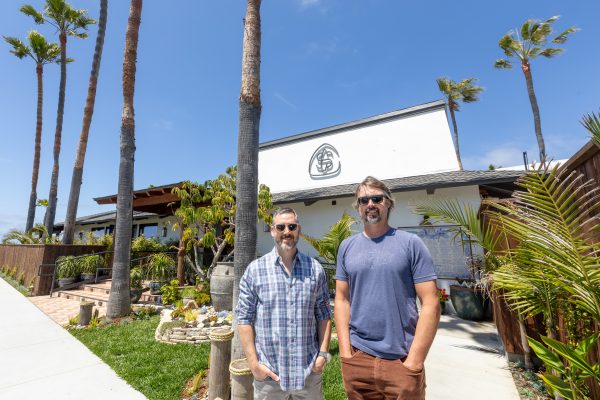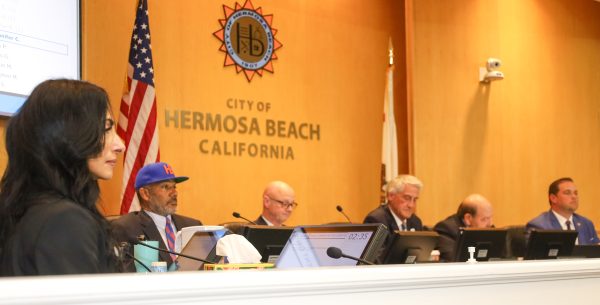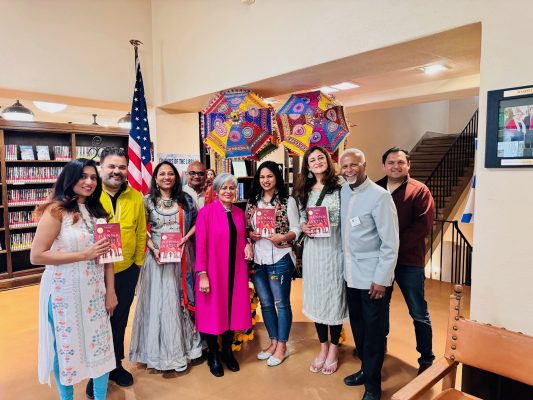
by Eric Volmer
“Anybody need sunscreen?” Ed Massey asks helpfully before he launches into his orientation to 50 or so Los Angeles County Junior Lifeguards and their family members who have arrived on a Sunday morning at the temporary headquarters of Portraits Of Hope in Marina del Rey.
“Ready then.”
Ed pulls on the beak of his red baseball cap as he winds up to pitch.
“This is the largest public artwork for kids ever seen in this country. I’m talking here about hand painting 100,000 square feet of panels, which we plan to install on 157 Lifeguard Stations along a 31-mile stretch of coastline, all the way from Zuma down to Palos Verdes, between May and October.”
Long, tall Ed Massey tosses a reassuring glance to his project co-founder and brother Bernie. Then he eyes the newcomers who are all hunched over their pre-stenciled 14-foot x 14-foot plastic panels.
“I want you to imagine bright, beautiful, bigger-than-life flowers, the very symbols of hope and renewal and also improbable abstract patterns for flavor, along with colorful fish to enhance the aquatic theme of the iconic lifeguard towers that have protected our shores for over 50 years,” Ed Massey says.
At this point on this happy-go-lucky spring morning, I’m wondering if the children sitting in a semicircle at Ed’s feet are getting all this. They are. You can see in their faces they’d like nothing better than to begin splashing all these Easter egg-colored paints from sea to shining sea.
“This is a display of dreams, folks, and we’re hoping that you’re not only going to have fun today, but also know you’re participating in an historic civic art collaboration with over 6,000 kids, including ones in hospitals and in isolation, as well as 2,000 adults.”
In the South Bay, a key volunteer is Redondo Union High student Sydney Gonzalez, who has organized a South Bay Chapter of Portraits Of Hope. Gonzalez is enlisting volunteers to paint all of the railings and bases of the towers this Sunday. She plans to have painting contractors serve as “generals” for the teams of 10 that will be assigned to each tower.
Benjamin Moore Paint is contributing 300 gallons bright lime, cheery blue, sunny yellow, deep orange, sweet pea green and lively purple paint for Sunday’s work.
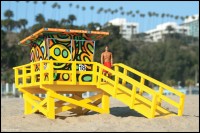
Welcome to the world of the Brothers Massey
As we pass into the lobby of their newly improvised studio on Mindanao Way, which was donated to Portraits Of Hope by the L.A. County Dept of Harbors and Beaches, I seem to remember it as the Disco Era ballroom of the Moose McGillycuddy nightclub. Now it’s a sunlit aquarium-like space decorated with posters of former feats of the Masseys and their friends.
There’s the floral pastel-camouflaged oil derrick in Century City, the first civic project they completed in 1995. Since that date their artistic efforts have taken many forms. There are tugboats in New York Harbor painted in their signature style. Then, there’s a photo of a blimp after the brothers had their creative way with it — and multi-colored NASCAR autos, and bi-planes at Kitty Hawk Field during the centenary celebration of the Wright Brothers’ flying machines.
Then, the piece de resistance: 5,000 New York yellow taxicabs all done up during one fall and called “Garden In Transit.”
That’s what starts one wondering about all the planning that the brothers do to make these projects blossom on the public scene.
“Portraits Of Hope began as creative therapy and hands-on activities for young participants. It grew out of my artistic training at UCLA and later Columbia University,” Ed said. “But, then, Bernie brought into it a sociological angle from his studies at UC Santa Barbara.”
Bernie bears a strong resemblance to his brother and conducts a ready duet alongside Ed.
“I see this artwork as a vehicle for opening up a whole inquiry about the world at large. It all moves along by volunteerism. That’s where I saw a way to use this power of teamwork in order to extend it to tens of thousands of participants,” Bernie said. He mentions the educational component of the project that they conduct on weekdays with school children and with various volunteer social service agency groups.
Now, they begin to layer on their descriptions with coat over coat. Ed points out, “Art is often a solo act, but here it’s different. Here it’s like riding in a subway — we’ve got 10 or so strangers, elbow-to-elbow, painting and making split decisions on how the artwork will appear in the end.
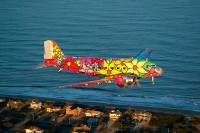
“The team of painters has to figure out how to bring a unified vision to each panel. That’s the collaborative part that brings young and old, and all backgrounds together to bring about something bigger than any one person.”
“Then,” Bernie says, “we can add the public information component. How do you make this a system of thought that can be applied throughout life, one that can be done anywhere? Here, for example, we give each kid a cardboard replica of a lifeguard tower. Now, looking from that tower, what social issues can they see that can be solved through cooperative action? I display a placard with a $100 sign on it and ask them if their towers were banks, how would they allocate that $100 to meet the challenges of each social issue? You’ve got lots of needs out there in education, the environment, health care, senior services, infrastructure, foreign aid, national security — you name it. I ask the students to reflect on how much they would set aside for each and why. And then to draw or paint a safeguarding message on their own tower.”
A supportive cast
Frank Bird, a recurrent Lifeguard and LACOLA Union board member, says, “I heard about the project on a visit to Catalina Island. I went to their website and realized it was a great way to be involved in something significant in my community. What’s especially amazing are the Masseys.”
“This is better than ‘Baywatch.’ It’s people participating in and celebrating the real beach life, not some fake Hollywood version. You grab a brush and size up a panel and in an hour or so you’re just flying along ‘zusssh, jusssh, zusssh,'” he says.
Expecting a more down-to-earth appraisal, I walk over to a very sober-looking lifeguard, Erik Albertson, who is photographing his friends, colleagues and junior charges.
“When you see all this before you, you really get it,” he says enthusiastically. “So many families here already, and I’ll bet you 175 people will have shown up by the end of this session. When this is all done, imagine lifeguards standing in these virtual works of art. We will become community ambassadors, as well as carrying out our duties in rescue and recovery, and also sharing a special sense of place with summer visitors.”
Simone, an 8-year-old student Culver City, discoursed on how these “lovely panels would be going to cheer-up children all the way over in Haiti and Chile after they were dismantled in October.”
So, I ask them, “How do you bring all of this off?”
Ed and Bernie switch-hit on this question. “Well, first of all, we don’t charge participants or the county. One hundred percent of the project is funded by the private sector,” says Bernie. “We do our homework and then we hit the ground running,” says Ed, drinking a whole glass of iced tea in one throw.
Back to Bernie: “Supervisors Zev Yaroslavsky and Don Knabe brought the relevant departments together for us and we demonstrated how we could do this for pennies on the dollar. Then, we made a lucky contact named Andy Boyle of Laird Plastics, who donated all of the recyclable plastic panels that you saw. Happily, we were introduced to Image Options and they came aboard — along with EFI Ink and SeeME, an European Company. Triple-A Flag and Banner will help with protective coats and Morely Construction is going to adopt 40 towers to install panels. Ford Motor Company joined in and the Weingart Foundation is funding our learning responsibility component.”
Ed adds: “Vista and Benjamin Moore Paints have given paint and we’re inviting groups of 10 to adopt railings now,” chugging down a third pitcher of iced tea.
At this point, I can see Ed and Bernie are about to blast-off back to the project-at-hand. “So, when do the panel installations go up on the lifeguard towers?”
“Mid-May,” they say, echoing one another.
And, what’s next, I ask.
“The Great Wall of China,” they answered together.
To volunteer to paint the lifeguard railings this Sunday or to help with the installations in May e-mail Sydney Gonzalez at sydrose@earthlink.net. ER

